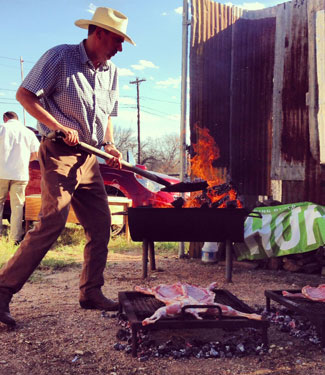My friend Molly O’Neill staged a Longhouse Revival food event in Austin, Texas on Feb 6, 2013. In preparation, she called me and asked who I would recommend as a legendary pit master in Texas that could help with a grilling demo of the Northern Mexico specialty of cabrito, or fire-roasted kid goat. She was looking for someone that could cook with authority, but wasn’t a celebrity chef. Of course, I recommended my husband, Kiko.
Kiko grew up grilling and can read a fire like city folks read street signs. Having grown up on a cattle ranch in the Northern Mexico state of Tamaulipas, evening meals usually consisted of lighting a mesquite fire and grilling chickens, steaks, rabbits, or on special occasions, kid goats. My husband knows how to calculate the time it takes to turn a mesquite log into the perfect pile of embers and how many of those embers are needed to perfectly roast any type of meat. Impatient, hungry glances and muttered complaints drift around the table when Kiko grills. He takes his time; he is never rushed. However, those complaints are quickly stifled once the carving board is delivered from the fire to the kitchen. His roasted meats are always savory, succulent, and crisped with just the right amount of char.
In the U.S., we don’t have the goat culture that my husband grew up with in Northern Mexico. Nonetheless, goat meat is becoming increasing popular in the U.S. Changes in ethnic populations have created a demand for cabrito in the supermarket, with production more than doubling in the last 10 years. However, the majority of carnivores in the U.S. are unfamiliar with the flavor of goat, and fewer still are familiar with the way cabrito should be cooked.
I asked my husband and Cuco, my concuño (brother-in-law) who sells cabritos as a side job, how one should select and roast a goat. Both Kiko and Cuco agree that the Gold Standard of cabrito is a kid goat no more than three weeks old that has never left the corral and has never been fed anything but mother’s milk. The breed of goat is not important but the animal’s age and milk diet are critical to good flavor.
[ pagebreak ]
To roast a goat, our two experts insist that the animal be roasted whole for best results, and in order to roast a whole kid goat, the carcass is usually splayed on an iron cross and balanced upright in front of a fire (which is called al pastor or goat herder style). Alternatively, the goat can be placed spread eagle on a grill, with embers piled around it. A larger fire is usually tended on the side, with embers moved and restocked as required. Total cooking time can take up to two hours, but variables such as wind and the size of the goat will determine the true cooking time. Practice makes perfect, so our children (three boys) are now learning to help their dad tend the fire and test the meat for doneness.
Molly’s event was an overwhelming success. We arrived in Austin with our sons, three cabritos, iron grills, an old shovel, and a truck full of mesquite firewood. Kiko spent the afternoon tending his fire and, by dinnertime, was able to serve samples of authentic mesquite grilled cabrito to every one of the 150 guests (a ‘loaves and fishes’ miracle, considering we only had about 18 pounds of meat). Humbly, my husband received accolades for his efforts, and even though the guests didn’t know him as a celebrity chef, by the end of the evening they certainly recognized him as the authority on cabrito.
Luckily, you don’t need an open flame and wide open spaces to cook up cabrito. Here’s how you can do it at home.
- 1 leg of kid goat, about 1 1/2 pounds
- salt and pepper, to taste



![Making Mealtime Matter with La Familia: Easy Sofrito [Video]](https://thelatinkitchen.com/wp-content/uploads/2015/10/sofrito-shutterstock__0-500x383.jpg)
![Easy Latin Smoothies: Goji Berry Smoothie [Video]](https://thelatinkitchen.com/wp-content/uploads/2015/12/goji_berry-shutterstock_-500x383.jpg)
















![Fun and Fast Recipes: Fiesta Cabbage Salad [Video]](https://thelatinkitchen.com/wp-content/uploads/2015/11/fiesta_cabbage_slaw-shutterstock_-500x383.jpg)









